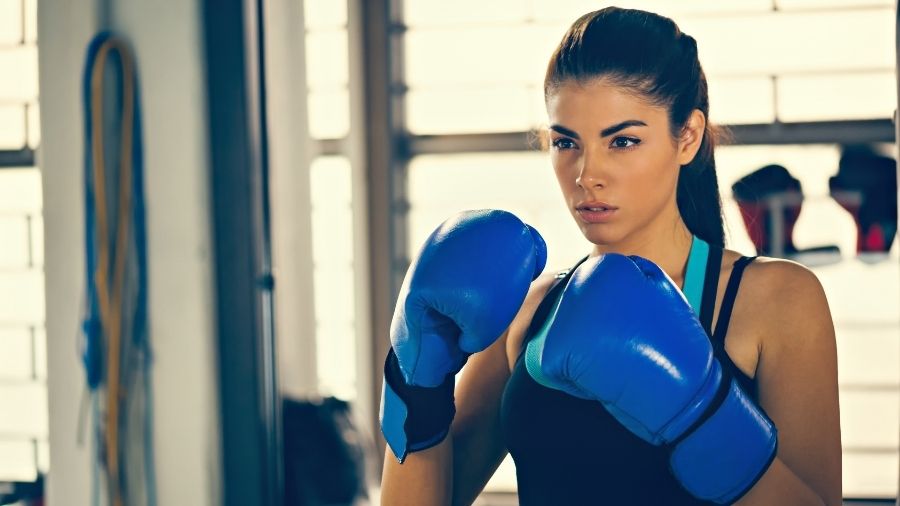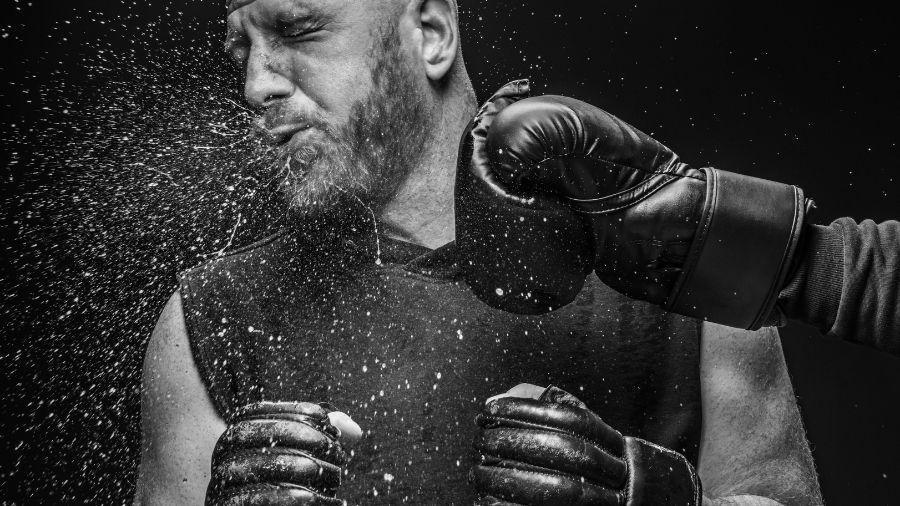Boxing and mixed martial arts are two contenders for the top spot in combat sports. Boxing has been on the throne for more than a century, but mixed martial arts has gained a massive fanbase in the 30 years it existed, and the two sports are often compared to each other. So, how do they stack up?
Boxing allows only punches and presents the pinnacle in the skill of fist fighting. MMA, on the other hand, is much closer to a real fight and encompasses all aspects of unarmed fighting, including striking with all limbs and grappling. The variety of skills and arsenal of MMA fighters makes them heavy favorites in one-on-one fights against boxers.
Boxing and MMA are the pinnacle of professional fighting, and people have always been fascinated by the spectacle of skilled violence.
Both will always have a hardcore fanbase downplaying the strong sides of the other, but in reality, their differences make them unique and equally important.
What Is Boxing?
Boxing has been practiced in some shape or form for thousands of years but became the most popular combat sport in the early 20th century and remains so to this day. It’s a striking combat sport where only punches are allowed, and the main goal is to knock the opponent out.
Boxing became the most popular combat sport in the early 20th century, and many aspects of it, like the ring, padded gloves, timed rounds, weight classes, scoring system, and others, were implemented by many other sports.
Boxing’s reliance on punching creates the necessity for other tactics to be used. At the higher levels of the sport, footwork, ring generalship, head movement, and tactics usually decide the outcome of a fight, which is why boxing is often called “The sweet science.”
This pursuit of the finer details of fighting is why our website has borrowed the term.
What Is Mixed Martial Arts (MMA)?

MMA, or Mixed Martial Arts, is a fairly new combat sport developed in its current form during the 1990s.
The term MMA was first coined in 1993 at the time the UFC was created, and, in essence, is a combat sport with as few rules as possible.
While mixed rules and style vs style fighting can be found in antiquity and later, during the 19th and 20th centuries, the modern sport of MMA officially began with the UFC.
MMA is a style that was developed by borrowing techniques from other fighting styles. As masters of different disciplines clashed, it became apparent a more well-rounded skillset was required, and fighters started using a mix of techniques from completely different styles.
Early on, MMA was not viewed favorably by the general public as it was too brutal. But during its first decade, MMA quickly evolved and was turned into a sport by implementing many rules.
Today, it’s a well-respected sport with the top fighters having the status of elite athletes from other sports like boxing, football, and basketball.
Boxing Vs MMA: Detailed Comparison
Rules
In boxing, the only strikes allowed are punches to the head and the body above the waist. Clinching is immediately separated in amateur boxing and is limited in pro boxing.
Boxing matches are fought in 3-minute rounds with 1-minute rest in between in a square boxing ring.
The number of rounds depends on the level of the contest. Amateur matches are limited to 3 rounds, while professional bouts range between 4 and 12 rounds.
The match can be won by a knockout, a technical knockout (the ref stops the fight to save the fighter from further damage), or a judge’s decision.
MMA, in contrast, is the combat sport with the most liberal ruleset. Strikes on the feet are permitted with every body part aside from the head. Most of the body is also a viable target, except the back of the head and groin.
A wide variety of takedowns throws, and trips are used to bring the fight to the ground, where fighters can strike and use submission holds like chokes and joint locks.
Most MMA fights are 3 rounds, with championship fights and UFC main events being fought in 5 rounds, all 5 minutes long.
Fights are primarily fought in cages that vary in shape, but some organizations hold MMA matches in a ring as well. A match can end via a knockout, technical knockout, submission, or a judge’s decision.
Techniques
Boxing has a very limited number of legal techniques. The fundamental punches are the jab, cross, lead and rear hook, and the two uppercuts.
Each of the punches has variations based on the distance, angle, and position it is thrown from.
However, the small number of techniques places more importance on other concepts like footwork, distance, and head movement.
In MMA, everything someone found to use effectively within the rules is used. In general, most punches are taken from boxing, and the kicks come from karate, Muay Thai, taekwondo, and others.
On the ground, there is another universe of moves and positions used in BJJ, Judo, wrestling, and many other grappling martial arts.
Stance
There’s quite a variation in boxing stances. Still, the fundamental boxing stance is with both feet shoulder-width apart, the dominant leg and hand staying at the rear, while the weaker one is leading. The knees are slightly bent, and the lead leg points at 45 degrees.
Both hands are up near the head. The boxing stance has to allow the fighter to move in all directions, attack with weight behind his punches, and defend in the shortest time possible.
In MMA, there are too many styles, each of which uses a different type of stance. The only common thing is the stance is staggered with lead and rear hands and feet.
However, punchers fight in a specific stance. Kickers fight in a very different stance, and wrestlers fight with their weight lower to the ground, etc, so there are some standard stances depending on the style.
In addition, you must often adjust the stance according to the opponent’s game plan. Even the best striker cannot use his usual stance against a grappler who aims to take the fight to the ground at any time.
Equipment
Some of the equipment needed to train in boxing and MMA is the same, but I will list them separately for both styles. The lists include everything you need for training, not competition, where much less protective equipment is used.
Boxing equipment
- Boxing gloves
- Hand wraps
- Mouthguard
- Boxing shorts
- Boxing shoes
- Headgear
- Groin guard
MMA equipment
- Boxing gloves
- MMA gloves
- MMA shin guards
- Mouthguard
- Headgear
- MMA shorts
- Rash guard
- Groin cup
Competitive Scene
The end goal of both sports is to win in a competition, and the competitive scene in both is fierce and brutal.
Boxing has been around for a century and a half, and the scene is more developed. You can have a successful career as a boxer without even entering the professional ranks.
Being an Olympic sport, boxing has an extensively developed amateur scene with government-funded national teams, school programs, and top-to-bottom architecture. This is something still missing from MMA.
On a professional level, boxing has a larger audience and general public recognition. However, MMA is rapidly growing in popularity.
Moneywise, in the upper echelons of the sport, boxers earn quite a lot more money than their MMA colleagues despite the brutal nature of MMA and the punishment they go through.
This is due to the long legacy of boxing and the time it has been at the top of the fight entertainment industry.
Another factor in this equation is that MMA fighters still do not have the leverage of boxers over negotiations and earn less of the overall winnings.
This means that if a boxing event and an MMA event earn the same total, the boxers will still take home bigger purses.
Strength & Conditioning
There is far more research in MMA than boxing regarding strength and conditioning thanks to the UFC PI. Strength training for boxing places more emphasis on speed with heavy resistance training playing a role further from a fight.
MMA strength training consists of a hybrid approach of grappling and striking. MMA fighters must be well rounded and will train across the force-velocity spectrum depending on their needs so will balance jumps, throws, and plyometrics with heavy lifts.
Both sports require the ability to repeat high-intensity efforts. Especially since 77% of all UFC fights are ended in the 8-14 second high-intensity work period. MMA conditioning may need more variety due to the different skills so specific conditioning with grappling and striking may be used more often.
Conditioning for boxing requires a large aerobic gas tank but high-intensity sprints should be used to enhance the muscles ability to resist fatigue.
Is Boxing Or MMA Better For Self-Defense?

All combat sports will give you some self-defense skills, but not all are equal. As full-contact sports utilizing regular hard sparring and competition, boxing and MMA will teach you how to defend yourself.
But in a direct comparison, you probably know the answer. MMA is undoubtedly better for self-defense as it involves various fighting styles and techniques.
MMA is useful in more situations. When you are attacked, you never know what the situation will be like, and by possessing more skills, you will be able to handle a wider variety of scenarios.
Regardless if you find yourself at close range, on the ground, or need to use kicks to keep your distance, you will always have at least one technique or skill from MMA to rely on.
Boxing is much more limited in this regard. A trained boxer is deadly in a street fight, that’s for sure, but if he gets tackled to the ground, things immediately start to look bad.
Another negative aspect of not knowing any grappling is you need to hurt the attacker to stop him. In boxing, you learn to knock someone out, which is not always the ideal solution on the street.
But when knocking the attacker out is the right solution, punching is the best way to do it, and no one punches better than boxers, so the sport has a lot of carryovers for self-defense. MMA is better simply because it gives you infinitely more attacking and defensive options.
Boxing vs. MMA: Who Would Win?

The answer is simple and has been answered in practice- an MMA fighter wins under MMA rules, and a boxer wins under boxing rules.
In general, though, things are in favor of mixed martial arts. The few boxers who have forayed into MMA without extensive training and relying solely on their boxing skills have failed miserably. James Toney vs Randy Couture is one of the few examples.
This hardly surprises anyone because the MMA fighter can always go to the ground where the boxer has no skills and dominate.
If we consider no rules fighting, the situation will be the same- the boxer has too few weapons and no answers for the arsenal of a well-rounded MMA fighter.
When the meeting is under boxing rules, the roles reverse. Boxing may be just punches, but there are subtler things to consider, and by spending a lifetime refining just one skill set, it’s natural for boxers to be the best at it.
Connor McGregor vs Floyd Mayweather is the example everyone knows of, but many more MMA fighters have gotten in the ring and lost to boxers.
But many of them also have fared well, which is a strong win on MMA’s part. Because all of the MMA vs boxing fights are done under boxing rules and not the other way around, MMA fighters are somewhat competitive in enemy territory.
If a boxer enters the cage, the results would be catastrophic for them, not competitive.
Boxing vs. MMA: Which Should You Choose?

The choice between MMA and boxing is personal and depends on your personal goals. But the first piece of advice I want to give is to sign up for the gym closest to you. A 10-minute travel time difference is insignificant, but an hour more means there is a much higher chance you will skip sessions.
So early on, it’s better to choose the closer gym, whether boxing or MMA, unless you are adamant about training one of the two.
With that said, boxing may be the easier of the two sports to get into. MMA has many techniques to learn at once, which may be too much for most people. Boxing has a more mellow learning curve for beginners.
However, there are so many subtle nuances needed to be the best at the highest levels that I can argue that boxing is the most challenging combat sport.
MMA is more versatile and more practical. It’s better for self-defense and makes you a complete fighter and a martial artist. Nowadays, everyone, even boxers, should have some proficiency in defending kicks, takedowns, and some of the most popular submissions.
The diversity in mixed martial arts also demands that the physical attributes be more well-rounded. You can’t go wrong with either sport. If the gym, the trainer, and the people training there are solid, you have made a good choice regardless of whether it’s MMA or boxing.

